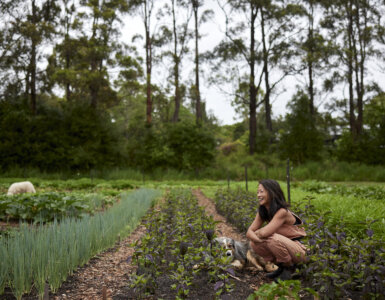In a world driven by artificial intelligence and autonomous machines, the agriculture industry is changing dramatically. But with more technology, does life become more complicated? One farming couple is striving to create better and simpler practices with farm-bots. Jocie and Andrew Bate from SwarmFarm Robotics, used their own farm in Central Queensland as the testing ground and now these mechanical helpers are being deployed to farms across the country.

The beginnings of SwarmFarm Robotics
Jocie and Andrew are the human faces behind the bots – and they absolutely love it. So much so, that Andrew’s favourite place on the whole farm, is his workshop. The family has been farming traditionally since the late 1970s, and it wasn’t until 2012 that they started to wonder whether there was a better way.
“SwarmFarm and the technology we develop now was kind of born from that, from a desire to farm better and more sustainably and to get to the next level.”
Contrary to what some may assume, the business is not about automating agriculture or saving on labour. The inspiration came to Andrew after purchasing yet another enormous piece of machinery.
“We bought bigger tractors, we bought bigger sprayers, we bought bigger planters. We realised as we made our equipment bigger, trying to get more efficient, we actually became worse farmers,” says Andrew.

Andrew recalls, when he started farming, the biggest tractor on the market was 420 horsepower; now it’s 830 horsepower. By comparison, the SwarmFarm bots are about the size of a small car.
“We’ve seen the supersizing of farming. SwarmFarm was born out of this desire to use robotics to be better farmers,” Andrew explains.
It means users can say goodbye to computers, wiring and excess buttons. Instead, a simple smartphone can operate these robots that were developed in partnership with local universities. After putting the first prototype to the test, they also discovered the smaller framework has less impact on the soil by reducing compaction and erosion.
“We learnt a lot about working with software development teams and engineers. It’s an entirely different world to on-farm, working cattle and growing crops.”

All the testing is done on the farm in Central Queensland.
“We are farmers and continue to farm,” says Jocie.
They describe the robot as a driverless car, making life easier.
“We build prototypes, test them, break them, build them again, design them better.”
The list of expertise required is immense with all the manufacturing done in-house and sold direct to farmers.
Small bots, big change
“The name SwarmFarm comes from the idea that instead of one really large machine, we put lots of little, small robots that work together to get the job done,” says Andrew.
Smaller farms might have one robot, whereas larger operations could have four or five. The robots run 24 hours a day, 7 days a week. Farmers can potentially save on pesticides and herbicides due to the precision of the bots.
“Often, they use 1% of what they would normally use. So, if you were going to use 100 litres of a pesticide, you’re now using 1 litre,” explains Andrew.
Better for the environment and the wallet.
SwarmFarm bots have now worked about 3-million acres of land.
“It’s quite exciting. We’ve got a lot of farmers now using our technology, and a lot of robots rolling out,” shared Jocie.

How robotics are shaping the future of agriculture
Many advocates see robotics as a means to attract the next generation into farming.
“We need to see our communities grow. We need to see our communities revitalised. This is actually driving a little mini revolution.”
The heart of this business lies in Central Queensland but it has the potential to have a global impact. Nothing is imported or re-purposed from overseas. It’s true Aussie innovation.
“A lot of people said, you can’t build a robotic company out in rural Australia. You need to be based in a capital city.”
Here’s to proving the doubters wrong – one bot at a time.
Hear more stories like this by subscribing to the Telling Our Story podcast on iTunes (or wherever you listen to podcasts) and follow podcast host Angie Asimus on Instagram for more updates.







































Add comment